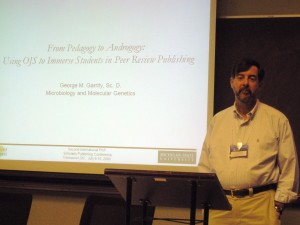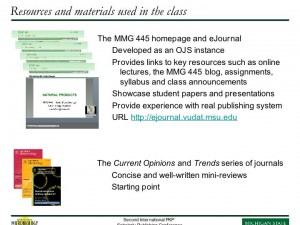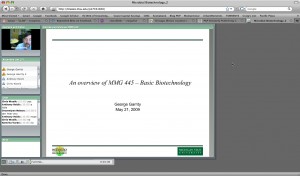Creating an Open Access Journal; A Medical Students’ Prospective: The Session Blog
Presenters: Steven Andrew Plato II and Andrew James Wyman (remotely), David Solomon in-house
July 10th, 2009 at 3:30 p.m.
Background info
Steve Plato and Andrew Wyman are third-year medical students from Michigan State University who saw a need in the literature for a dedicated place for medical students to publish their work and founded The Medical Student Research Journal (MSRJ) in 2007. They are due to publish the first issue this fall.
Session Overview
The session got off to a rough start with a few technical difficulties (due to new too-loud speakers in the meeting room at Simon Fraser University). The students gave the presentation from their editorial room in Michigan via Adobe Connect Pro. They use this to connect with the many geographically diverse authors/editors/faculty associated with their journal. The image, Powerpoint and voice are very clear. This is an exciting software tool for all distributed learning models.
The students went on to explain that they started the journal to fill a gap. Most students have extensively researched their chosen field of specialty throughout medical school, but often do not know how or where to publish their work. Whereas 60-100% (depending on specialty) of medical students matching to their first-choice residency stated they had extensive research in their field, the proportion of those that had published was as low as 35% for some specialties. MSRJ is peer-reviewed, authored and edited entirely by medical students which they hope will be the go to journal for medical students to publish that work.
This project was started at the Michigan State University but the creators hope to reach medical students throughout the US as well as internationally. THE MSRJ uses Open Journal Systems (OJS) and Creative Commons licencing to ensure communication and availability of publication to all medical students. This project is similar to a one started a few years earlier by the same institution (MSU) in a graduate biotechnology course (see session blog from this conference) however on a much quicker timeline, around 28 days!
OJS has been very helpful for the med students as it helps to facilitate their multi-location system, has low overhead and allows them rolling publication with minimal delays. They also like the management tools that help to guide novice editors (reminders/checklists) to make the process simple. OJS also tends to being in a larger readership.
Faculty
Faculty assure quality peer-review. Students are trained by faculty in critical appraisal, principles of scientific writing and academic integrity. They are also able to review a mock article and can compare their reviews to similar good and poor examples to learn to become a better reviewer. Faculty also provide guidance on sustainability and establish good practice in mentees (more hands-on and one-on-one time with people who know the literature the best). The students all go through an online training module, from the Annals of Emergency Medicine, prior to starting as well.
Usually one faculty will mentor 3-4 students per article. This helps less experienced reviewers in specific fields. They also provide feedback and guidance on where a review may be lacking. Students can then re-review and submit, then the editor decides to accept, accept with revisions or decline the article.
Sustainability plans?
Many other journals before this have struggled with longevity. MSRJ have instituted a student replacement policy (juniors that will take over when the current editors are done) and training sessions for editors which serve as quality control. In addition a letter from the Dean will be placed into the student file for encouragement to participate and to continue the job. Faculty are also rewarded by recognition in published material as well as a formal letter to their respective Departmental Chair. An annual report with statistics on publications is also planned for accountability
Finances?
The students plan for this journal to be a free or very low cost venture. All labour is by students or faculty. There is a minimal cost for the website host, however their major cost is copyediting, which they hope will be eliminated by using university resources. XML generation is also a marginal expense as is website development.
Benefits
The students feel the benefits are quite clear. They build experience in scientific writing and editing as well as get a head start on publications for their career. It is also strongly beneficial for those students doing research outside academic centres such as rural and distributed sites.
Since Open Journal System (OJS) has become a forerunner in educational resources, many other institutions have been able to start similar projects, with one just ready to launch this fall here at my home institution, UBC. The UBC Medical Journal will provide medical students with a forum to publish their research work that previously had no definitive place for publication.
Questions from the audience
1. I understand medical school is an intense experience. Do you have to sacrifice other parts of the educational experience to participate?
While it is true it is intense, but one thing about medical school is it does allow you to do things outside of school. Most students are involved in extracurricular activities already and 60-100% already involved in research. There will be some sacrifice, but usually that would be less time for research projects (i.e. one instead of two). The time intensity of the reviewer part of the job is not significant. Students only review one article at a time. There is a base here already, but it does take away time, hopefully that time is well spent.
2. Are the training materials you used publically available?
Yes they are online in the Annals of Emergency Medicine Journal. They have a great online flash based training process that we used.
3. Do you plan on only accepting articles from MSU or do you plan to open the journal up to other universities?
This journal will be open to med student/residents around the world once it is started. MSU is unique in their distributed plan in the states. Right now, you can submit from anywhere, but we hope to expand reviewers across the country.
Related links
The Medical Student Research Journal
Andrew@msrj.chm.msu.edu
Steven@msrj.chm.msu.edu
dsolomon@msu.edu

July 10, 2009 Comments Off on Creating an Open Access Journal; A Medical Students’ Prospective: The Session Blog
From Pedagogy to Androgogy: Using OJS to Immerse Students in Peer-Review Publishing: The Session Blog
Original Abstract Title: An Online, Open Access, Student-Authored and Peer-Reviewed eJournal in Biotechnology
Presenter: George M. Garrity
July 10th, 2009 at 9:30 a.m.

(Used with permission from George Garrity)
Background info
A course (MMG 445 Basic Biotechnology) taught at Michigan State University by George Garrity has been a leader in student open access knowledge publication. The curriculum ensures its students learn the rigorous method of peer review in their field by becoming both authors and reviewers. The course and website follow Creative Commons licensing and pay particular attention to intellectual property. The students hope to be published at the end of this course after surviving the said scientific methods of journal editing and learning about biotechnology to boot.
Session Overview
The session starts with Professor Garrity describing a 20-year old course description that claims to deliver thoroughly out-of-date biotechnology topics and methods. You would think this would mean a zero percent class registration, but in contrast the class has been increasing in size every year and the university has placed a cap at 50 students! Word of mouth has ensured that this important course for all students is continued. Why is this course important you ask? Garrity goes on to explain that there are 5 essential elements students need to possess and are rarely taught in school:
- Curiosity
- Open to new ideas
- Problem solving
- Critical reading and listening skills
- Ability to express oneself clearly (written and verbal)
He continues on to describe what happens in the real world and skills you need to possess to become successful in your field:
- work on multidisciplinary teams
- be adaptable
- ability to acquire new skills quickly.
He shows how the course has changed over the 10 past years and how the course has come from a traditional lecture based series to a now completely virtual university with all lectures given online and students able to blog/chat online with each other and professor at the same time. He has instituted a blog for students to ask questions about the given weekly lecture (and this is the class participation mark). The students do not get away with mindless, redundant questions either. They will get thrown back to the students to revise.

(Used with permission from George Garrity)
The course is structured into 4 assignments:
- Review paper (topic of their choice from Current Biotechnology) 30%
- Student Reviewer (4 other student papers) 30%
- Presentation of their paper 30%
- Class Participation 10%
Garrity and invited expert guest lecturers ensure that the whole process is valid and conforms to proper methodology. They also ensure that students are true to their said interests and get the work authored and reviewed in a timely fashion. The whole process has to be completed in one academic semester (13 weeks). There is a 70% acceptance rate and students are held to high standards. He relates to the class the importance of publication and how the scientific community uses this process to communicate, gain recognition and as a tool of quality control.

(used with permission from George Garrity)
The student publications can be viewed online via the Open Journal System and have been thoroughly cited in Google scholar. These review article have been cited by other peer-reviewed articles multiple times, have been published by Elsevier and have been used in hiring interviews. Student Alumni have come back to class to give ringing endorsements of the reality of the class and well as to become teaching assistants or guest lecturers.
One of the biggest components is the no-tolerance policy on plagiarism which is painfully spelled out by Garrity in class and even goes on to tell the students how he will catch them. You would think this would turn students off of the idea, but he still gives examples of multiple plagiarized papers each semester.
As stated above the course goes beyond plenary sessions to include the above unique writing as well as faculty and student-generated online videos. They do this using Web 2.0 online programs (Adobe Connect Pro/Skype) which are similar to Jove (Journal of Visualised Experiments). Please see the YouTube tutorial below for an example of how Adobe Connect Pro works. These are easy to use and cheap to install in the classroom.
Questions from the audience
Most questions centred around plagiarism and how he could detect the multiple examples.
The shared techniques from simplest to complex were:
- multiple different fonts in a paper
- multiple writing styles in a paper
- undergrad level English/grammar forging into graduate level writing and then back again
- use of technically perfect writing, however strung together in such a way that it made no scientific sense
A specific technique he used centred around an “anchoring” word which is a word that shouldn’t be used commonly that appears. He places this word with three or four surrounding words in google and tries to find wrong citations or mis-citations. All evidences of plagiarism is reported back to the Academic Council and Dean.
Notable Accomplishments
The eJournal continues to increase in circulation with >92,400 downloads to date (Source).
Seven student articles have been downloaded > 2000 times and 23 papers over 1000 times (Source).
The eJournal has been chosen as the first place recipient in the 2007 MSU-AT&T Faculty-Staff Awards for Instuctional Technology.
Related Links
Scientific Writing Reference texts

July 10, 2009 1 Comment
